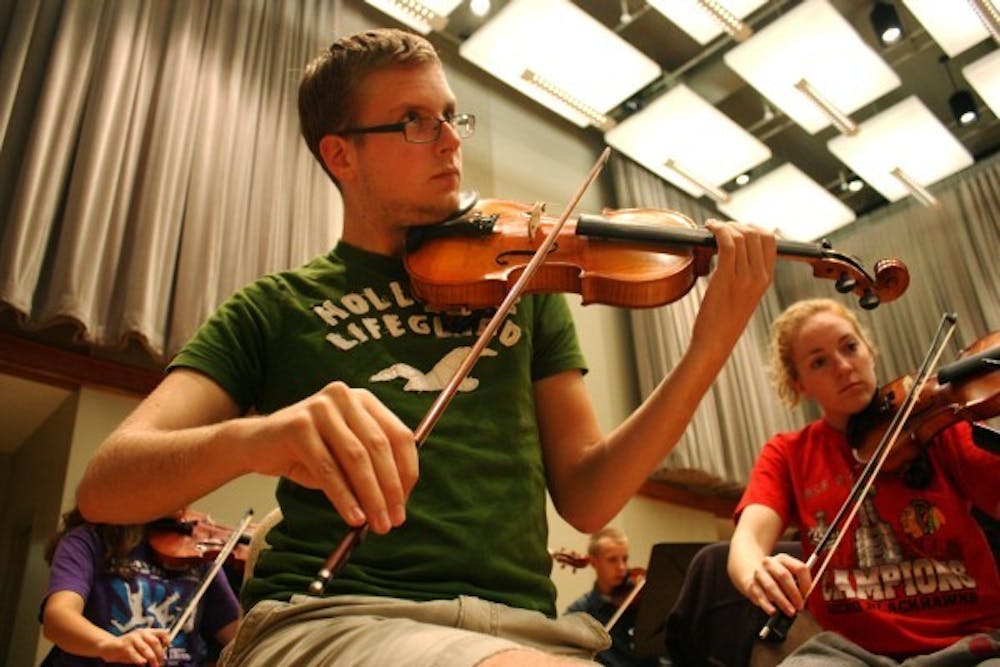With their backs straight and eyes attentively staring at their music or the conductor, students play their instruments, emitting ambient sounds. The music fills the high-ceiling, wood-floored room cluttered with chairs and music stands.
This is how students from a newly started orchestra program at Ball State prepare for rehearsal every Monday night at the Music Instruction Building. The Ball State Chamber Orchestra allows non-music major students to perform in an ensemble not related to the Ball State Symphony Orchestra.
Chris Coonradt, orchestral conducting masters student, runs and conducts the new orchestra, which is also sponsored by Bohuslav Rattay, director of orchestras.
"I've seen programs like this in many other universities, and I really wanted to get one started here at Ball State and hopefully watch it grow," Rattay said.
Having only started planning and recruiting in the middle of last semester, followed by a "test drive" of the program soon after, Coonradt and Rattay said they have about 25 students performing in the orchestra.
"We want this to be a very easy-going thing for the students," Coonradt said. "We don't want them to be intimidated or feel stressed out, but rather let them have fun while still learning."
Rehearsals reflect the limited stress environment Coonradt said he is hoping to achieve. As soon as students enter the room, they are greeted by friendly hellos and smiling faces. The overall calming atmosphere almost immediately abates any nervousness a student may have.
Some students said Coonradt's goal to create a stress free environment is working.
"I am not at all feeling the stress of trying to juggle school work while having to learn and practice new music," Anna Simmons, sophomore biology major, said. "In fact, this relieves the stress I receive from school work, not add to it."
The non-demanding aspect of the program is what attracted freshman journalism major Sam Harsh.
"I didn't audition for the official orchestra because auditions have always made me nervous," Harsh said. "Here, there's no auditions and it's very easy-going and [a] friendly environment."
Interest in staying in the program is sustained by having the students introduced to a variety of different types of compositions.
"We will usually have the students play classical music such as Beethoven, but we've already, and will continue to, throw in some pop culture pieces, such as movies scores composed by John Williams," Coonradt said.
He also makes sure to keep rehearsals moving by having the students play two to three compositions a rehearsal. This keeps the students focused and entertained, two key aspects to getting the best out the students.
People who are just learning instruments should not be afraid to join. In fact, Rattay encourages them to join.
"We want people to know that this program is open to everyone," he said. "We encourage people to join because we really think they'll have fun."
Allowing jokes and comedic breaks during rehearsal is one of the ways the calm and enjoyable atmosphere is kept.
Coonradt said he knows it can be very difficult and stressful to try to learn an instrument, and he hopes he can incorporate enjoyment and learning into his rehearsals.
"There are a lot of the players here that are trying to learn new instruments and haven't played in an orchestra before, so we do want them to practice, but we also don't want to be too demanding from them to the point where they stop having fun," Coonradt said.
As the students pack up and get ready to leave, there is still friendly chatter going on. Most linger in the room for a few minutes, talking amongst themselves and some talk to Coonradt, but most have smiles on their faces.
"What makes this so fun is everyone here is so nice," Simmons said. "It is very easy to get along and enjoy ourselves."



